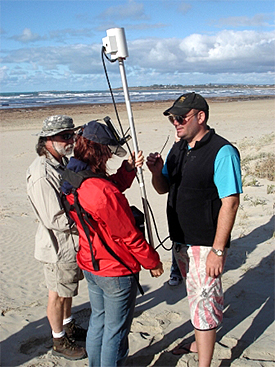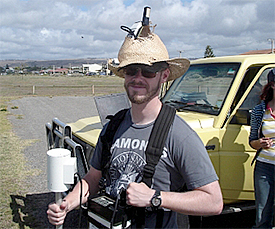
Flinders University 2007 Field School
in Underwater Archaeology
8 February 2007
By Agnes Milowka
Today has to be put into perspective - the last three days the ‘Green Machine’ has been slogging it out just to reach our survey site. The Star of Greece inconveniently wrecked 1.4km from the closest beach access, which for us meant ‘death marches’ dragging all our gear, including tanks and weights across the sandy beach. All worth the effort of course as it’s a gorgeous little wreck, great fun to survey and with an interesting history to boot. You can tell my muscles are no longer sore and I can look at the bright side of things… at the time the team motto was ‘we will forget the wreck… we won’t forget the walk.’ Given this, the idea of putting up our feet and taking a gentle stroll on the beach holding a magnetometer was most appealing.
To some, walking backwards and forwards with a mag in hand might seem a tad on the boring side – not so the green team - we had a fabulous time! Bit of sunshine, blue skies, a beautiful beach and most importantly nothing too heavy to carry… who could ask for more?

Agnes gets a briefing on how to use the magnetometer.
But it’s not all beer and skittles. First, I had a mag slapped onto my chest, then a pole with the mag head shoved into my hand and finally a GPS was attached to my head! I was officially geek girl and looking like a goose (and secretly enjoying every minute!). If nothing else, we certainly attracted the attention of the locals and the beach goers.
Further woes included the rather pungent odour on the beach as the seaweed piled up. Of course equipment issues stayed with us. Short story: make sure the mag has plenty of juice left in it, as it doesn't seem to work too well with drained batteries... and it's a great idea to make sure the GPS turned on before embarking on a 2km walk.
So we spent the day 'mowing the lawn' looking for the remains of the schooner Emu, which reportedly sank on the 28th of April 1853. She tried to return back to Port Elliot to seek shelter after getting a flogging from the elements. The rough weather meant the crew weren't able to bring her into the harbour into a safe mooring and instead they dropped an anchor. Here she was exposed to heavy swell and dragged straight onto the sharp edges of Frenchman's Rock. In the morning her scattered remains were found on the beach driven up on the sand. Her captain and crew perished, the only remainder were the washed up Captain's hat and logbook.

David Kalinowski with the GPS strapped to his head.
From an archaeological perspective it would be a real find given it’s a rare example of an early Australian built ship and could give us great insight into the methods and materials used in the construction of these.
Today we were doing a preliminary survey and walked many kilometres, in fact we did 14 one kilometre tracks at about 2m intervals. Later on in the week the other teams will narrow down the search patterns to the anomalies we hopefully... found, and concentrate their search patterns. Tomorrow we are away from the field and onto the hard stuff. We will have our faces stuck to a computer screen interpreting the data collected, for which our sun burnt skins will surely thank us for.
Comments, questions, or suggestions?
For field school related issues please contact: jennifer.mckinnon@flinders.edu.au
For website related issues please contact:
mua@keimaps.com
Return to Project Journal home page.

